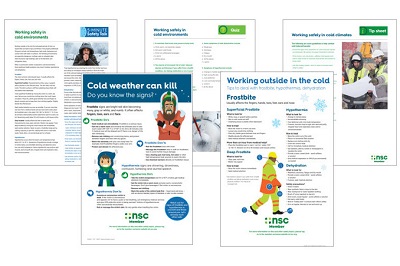Stay Safe While Working and Driving this Winter Season
As the winter months arrive, colder temperatures and inclement weather create additional risks while working and driving. According to Injury Facts®, winter weather and storms in the U.S. led to hundreds of deaths and injuries in recent years. Get ahead of these hazards now so you can stay safe at work and on the road. Use these member resources to learn more about what to expect and the steps you can take to protect yourself, your co-workers and your loved ones during the winter months.
Working in the Cold:
Safety Talk: Working Safely in Cold Environments I 2-Minute Video: Cold Weather I Poster: Working Outside in the Cold I Poster: Cold Weather Do's and Don’ts I Tip Sheet: Working Safely in Cold Climates I Quiz: Working Safely in Cold Environments
Winter Driving:
Safety Talk: Winter Driving I 2-Minute Video: Be Prepared for Winter Driving I Poster: Winter Driving I Checklist: Winter Driving
Prepare for the Hazards of Working in the Cold
Working outside in the cold brings plenty of risks that can quickly lead to injury and illness if not properly addressed. From dampness and below-freezing temperatures to high winds, it’s crucial to prepare ahead of time for the major hazards of working in the cold.
There are three significant health problems to watch for in cold environments: frostbite, hypothermia and dehydration. While the signs and symptoms of these conditions can vary, they can all create serious risks when working outside. Know what to look for and how to treat each of these dangers so you can help protect yourself and your co-workers.
If you plan to work outside in the cold – even for shorter periods of time – use these tips to stay safe:
● Know the signs of frostbite, hypothermia and dehydration, and know the proper treatment methods for these conditions
● Use the buddy system, working in pairs to keep each other safe
● Drink warm, non-alcoholic, caffeine-free liquids and eat warm, solid foods to stay hydrated and preserve your body heat
● Take regular breaks inside to rest and warm up
● Wear several layers of loose clothing for insulation and wear synthetic fabrics close to the skin
● Wear waterproof, insulated boots
● Protect your ears, face, hands and feet in extremely wet or cold weather
● Avoid touching cold metal surfaces with bare skin
In a winter weather emergency, you and your co-workers may need to take action to keep each other safe. Download the NSC first aid app so you’ll be ready to give first aid for frostbite, hypothermia and many other emergencies.
Stay Safe on Winter Roads
Winter driving can be harrowing, even in areas with milder climates. From icy streets to whiteout conditions, staying safe on winter roads is all about preparing your vehicle and knowing what to expect.
Before the winter season fully sets in, get started winterizing your car with these steps:
● Test your battery and your wiper blades, and replace them if needed
● Be sure your tires have at least 2/32 of an inch of tread and consider winter tires if you expect plenty of snow and ice
● Check and adjust your tire pressure regularly as it can drop in cold temperatures
● Use wiper fluid rated for -30° F
● Keep your gas tank at last half full
In addition to these steps, use these tips before each drive in the winter:
● If there’s snow on your vehicle, brush all of it off – not just the windshield
● Clean your car’s external camera lenses and side mirrors
● Remove dirt, ice and snow from sensors so they don’t interfere with features like automatic emergency braking
● Consider warming up the car before you drive but never leave it running in your garage, even with the garage door up
● If the forecast looks bad, consider waiting out the storm; if you must travel, share your travel plans and route with someone before you leave
When driving in the winter, keep two main rules in mind: slow down and increase your following distance. These simple steps will give you more time to spot hazards, react to unexpected situations and bring your car to a safe stop.
Finally, make sure your car has a well-stocked emergency kit, with everything from a properly inflated spare tire and a shovel to jumper cables and warm clothing. Check out this full overview of what to keep in your car and talk to your loved ones about stocking the same items in their vehicles.
Plan Ahead for a Safe Holiday Season
Safety Talk: Holiday Safety I Poster: Bring Safety Home for the Holidays I Poster: Holiday Safety at the Office
For many, the holiday season is a time for celebrations and sharing gifts. While you’re preparing for the holidays and ticking items off your wish list, use these new resources and tips to bring your loved ones the gift of safety.
Stay Safe While Decorating
When planning your decorations, place wreaths, trees and other flammable items away from fireplaces, radiators and other heat sources. Prevent falls when putting up decorations by using a locking step stool or ladder, and always place them on a solid surface before using them. Be sure to check lights for fraying or bare spots, and turn them off when not in use. And if using extension cords, keep them out of walkways and never overload them; if your cord isn’t long enough, find a longer one instead of adding a second extension cord.
Celebrate Safely
If you’re hosting friends and loved ones this season, clear your outdoor walkways of slipping hazards like snow, ice and other debris. Practice food safety while cooking by always washing your hands, utensils, sink and anything else that touches raw meat. And, help your guests plan for a safe ride home by offering festive, non-alcoholic drink options and helping to arrange trips with designated drivers.
Take Care of Yourself
The stress of the holidays can feel overwhelming even as the celebrations continue. Use these tips to take care of yourself so you can enjoy the holidays:
● Watch for signs of mental distress, from changes in appetite or sleep patterns to feelings of being drained or lonely
● Practice physical self-care over the holidays by eating healthy, getting regular exercise and aiming for seven to nine hours of sleep each day
● Take regular breaks from the news and social media, and lean on your support systems when needed
If you aren’t feeling like yourself, don’t ignore it; reach out to your supervisor, human resources rep, health care provider or employee assistance program for additional help. And, have a plan if a family member or loved one – especially someone who has struggled in the past – shows signs of mental distress.





